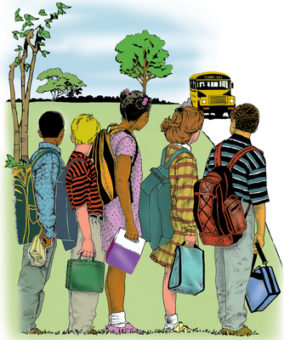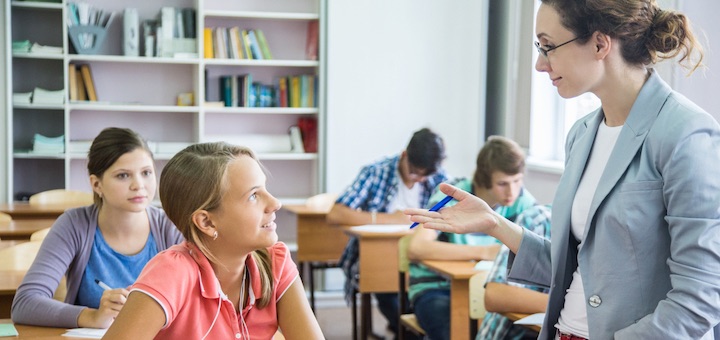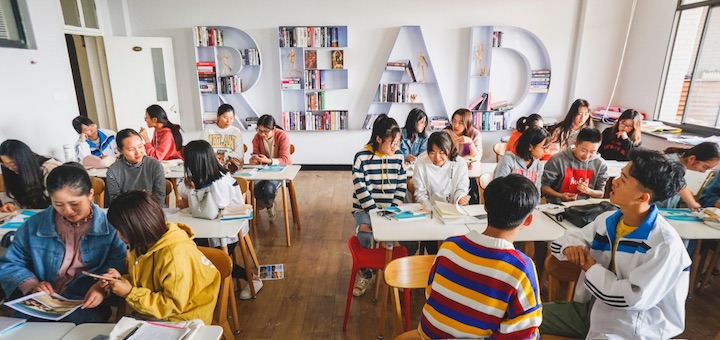 Who will be coming in your classroom door this fall? Upper elementary kids who are still thinking concretely? Young adolescents who suddenly aren’t themselves, sometimes feeling childish and other times wanting to be treated as adults?
Who will be coming in your classroom door this fall? Upper elementary kids who are still thinking concretely? Young adolescents who suddenly aren’t themselves, sometimes feeling childish and other times wanting to be treated as adults?
Whoever they are, we know you’ll be there to greet them with a reassuring smile as they enter your learning community.
We’ve picked out a selection of MiddleWeb articles offering a variety of back-to-school strategies that can help make every new student feel welcome. Each post is written by a teacher who knows what it’s like to stand at that door!
►How Can We Improve the First Days of School?
Most students are excited to get back to school, but anticipate lots of rules and mundane tasks to begin the year. Why not hit the ground running? Teacher educator Curtis Chandler has ideas to create a good first impression with plenty of fun, challenge, and learning.
►3 Ways to Relieve Back to School ‘Overwhelm”
In Julie Hasson’s annual back to school dream, she’s trying to organize thousands of rubber ducks in a rushing river. Fortunately she has strategies for dealing with that sense of being overwhelmed. They begin with a well-sorted to-do list and a focus on realistic optimism.
►Building Relationships with Kids from Day One
By putting strong relationships at the fore, you can cultivate an environment in which each of your students can grow. Through her many years in the classroom Stephanie Farley has hit upon keys to encourage kids to thrive. At the center – kindness and getting to know each one.

►Creating an Inviting Classroom Environment
Now’s the time for a fresh classroom environment! Consultant and author Barbara Blackburn shares ideas and resources we can use to create a learning space with activities that will be positive for all students, build strong relationships, and offer a pleasing place to gather.
►My 3 Teaching Intentions for the New School Year
At times we can be overwhelmed by all the fresh ideas we want to try out in a new school year. By narrowing her goals down to three top priorities, Megan Kelly aims to make lessons more meaningful for students, improve family engagement, and do better at tracking individual progress. In Getting to Know Students Can Deepen the Learning Megan writes about improvements in her student relationships after trying out strategies adapted from Zaretta Hammond’s Culturally Responsive Teaching and The Brain.
►Co-Create a Learning Culture with Students
What teachers do the first weeks of school has a dramatic effect on student engagement and achievement the rest of the year. Building a classroom culture of learning and questioning – co-created with students – paves the road to success. Jackie Walsh and colleagues show us how.
►Kids Need Us to Keep These 25 Promises
What promises do we need to make (and keep) so that our students will truly believe they belong in our classrooms and will be safe and cared for there? Middle grades leaders Laurie Barron and Patti Kinney break down the 25 promises they feel have the most impact.
►Consistency: The Invisible Backbone of Teaching
Students need to know what to expect when they enter our classrooms, writes teacher Kelly Owens. Consistency on the front end paves the way for more student autonomy and engagement throughout the lesson. Three tips can help teachers achieve “the loyalty to learning we want!”
►Keys to Fostering Joy in Your Classroom
The more Kasey Short considers joy when planning lessons and responding to students, the more everyone enjoys time together and the more they learn. Her joyful tools include celebrating, sharing ‘fun’ texts, students choosing music, moving indoors and out, laughing, and more.
►Humor in Our Schools Heals and Engages Us
Author and master teacher Debbie Silver begins her case for spirit-building humor and laughter in classrooms and schools with a personal story from her years as a middle level educator. “Pay attention to how much you laugh together. Teachers and school leaders who laugh, last.”
►Flexible Seating Creates Vibrant Learning Spaces
As she works on a grant proposal to fund an update of her classroom furniture, Kathleen Palmieri shares what she’s learned from researching how students benefit from flexible learning environments, including boosts in creativity, engagement, collaboration, focus and achievement.
►Classroom Moves That Stimulate Kids’ Learning
Whether when school opens or returns from winter holidays, don’t hastily jump on the bandwagon with the latest decorating fad. Design a place where students want to learn and grow. Your classroom environment may be one of the most powerful tools in your teaching toolbox, writes teacher and former marketer Kelly Owens. For even more design guidance, take a look at Curtis Chandler’s What Research Tells Us about Classroom Decor.

►How to Be Strategic with Scaffolding Strategies
Scaffolding strategies need to be used strategically, writes depth of knowledge expert Dr. Karin Hess. A strategy intended to support executive functioning or language development may not be effective for deepening content knowledge and thinking. See her tips and tools.
►10 Snapshots of Effective Middle School Teams
Over 40 years of research on successful middle schools has verified the amazing benefits for students of interdisciplinary teacher teaming. Author, consultant and middle level evangelist Jack Berckemeyer offers 10 snapshots that define the characteristics of effective teams.
►In the New School Year: Simplify, Unify, Multiply
A new school year brings excitement and organizational challenges. Expert Frank Buck suggests ways to streamline online communications, simplify classroom policies through teacher collaboration, and help kids develop as responsible members of a purposeful community.
►Use ‘First 20 Days’ Planning to Prep Kids for Success
Be ready for the school year with 4-week learning calendars that identify critical routines for school success and guide instruction that enhances working memory. Shannon Costley and Susanne Croasdaile share tips to ensure this brain-based strategy meets your students’ needs.
►Lesson Improvement Notes: Be Kind to the Future You
Lesson plan improvement notes written a year ago may not be as useful as you now wish they were. That’s what Lauren Brown discovered when she tried to decipher scribbled comments on materials from last fall. Learn some of her ideas to lessen the need for total recall.
►Rethink First-Day Writing to Better Engage Kids
Literacy consultant Shawna Coppola urges us to rethink the familiar start-of-year writing activity – the personal narrative. In its place she suggests a framework of ideas to free students to write about what interests them. As we try new approaches, we also renew ourselves.
►Welcome Students with New Fiction This Fall
2024 is another fantastic year for new middle grades books with many more titles to come in the next few months. ELA teacher Kasey Short introduces titles for school and class libraries that are sure to appeal to your students. Fantasy, immigration, science, WW II, and more!
►First-Week Activities My Math Classes Loved
Michelle Russell’s first week back in math class went great. Learn how she launched her classroom communities, thanks to teachers whose activities and ideas she scouted out online. Michelle has included all the students’ favorites in case you’d like to try some yourself! She also shares ways to help students with math anxiety in Starting the Year by Calming Math Qualms.
►How to Build Effective Student Teams
If you are a STEM teacher, you’ve likely made productive teamwork one of your goals. Just as likely, you’ve probably learned that simply putting kids in groups does not automatically make this happen. Anne Jolly shares a step-by-step process to build successful teams.
Book Reviews
►Class Libraries to Inspire and Challenge Readers
Using their own experiences with classroom libraries and ideas from other professionals, Colby Sharp and Donalyn Miller provide insight, wisdom, and actionable practices for teachers in The Commonsense Guide to Your Classroom Library. Katie Durkin highly recommends it.
►Strategies to Integrate AI into Every Classroom
Donnie Piercey’s 50 Strategies for Integrating AI offers a comprehensive guide for educators ready to harness the potential of AI. Piercey includes a wide range of practical strategies and insights to enrich the learning experience for K-12 students, writes Kathie Palmieri.
►A Playbook for Student and Teacher Well-Being
Grounded in research and real-world situations, The Social-Emotional Learning Playbook by Nancy Frey, Douglas Fisher and Dominique Smith supports the social-emotional growth in you, your students and your community, writes Anne Anderson, calling the book “a great PD resource.”
►Here’s How to Welcome and Engage Newcomers
In Teaching and Supporting English Learners, Eugenia Mora Flores and Stephanie Dewing combine research, practical application, and anticipatory guidance to create an immediately useful guide to inclusive learning environments that foster a sense of belonging for newcomers.
►Aligning How You Lead with Who You Are
Engaging with What’s Your Leadership Story? by Gretchen Oltman and Vicki Bautista will help leaders – especially newer ones – articulate their purpose and bring their whole selves to school each day. School leader Sarah Cooper appreciates the book’s practical honesty.


